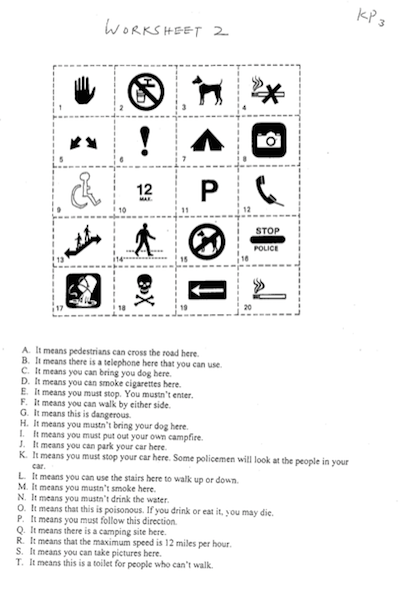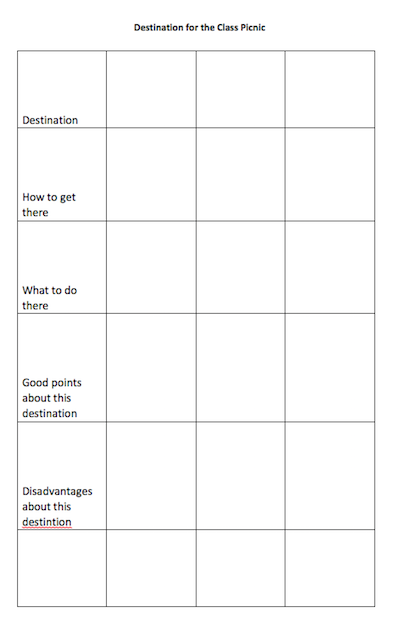From Controlled Practice to Communicative Activities
Objective: To provide examples of oral grammar practice activities that range from highly controlled to highly fluency-oriented.
Watch the following pre-class video, and then do the quiz. Please note the deadline for completing the pre-class Quiz.
Identifying the Target Language Item
View an extract from a lesson that follows the audio lingual method. Identify the language item(s) that the teacher is drilling the students on.
What are your thoughts on this kind of drill activity? Are you in favour of, or do you have reservations about, such oral drills? Be prepared to share your thoughts with the whole class.
Finding Out about Types of Controlled Practice
Read the following document to find out about some formats of drills. Then think of 4 prompts (words, phrases, sentences/questions, or pictures, or a combination of them) that can be used for a drill that practises:
Prompt: …
Response from students:
-
- He doesn’t like chocolate.
- She doesn’t like hotdogs.
- He doesn’t go to that school.
- She doesn’t drive.
Livening Up Drills with Pictures
Step 1:
Look through the following 3 resources, which all contain pictures. Think about how they may be used as prompts for drills.

Picture sheet for drills
Worksheet for practising You can vs You can’t
A PPT for drilling I can see/hear …
Step 2:
The tutor will conduct drills using the above picture resources. Take part in the drills as students.
Designing a Drill
In pairs, design a drill for practising Present Perfect:
-
- ‘Have you ever …’
- Yes, I’ve …before./No, I’ve never …
Think of 5 prompts that you will use. These prompts can be linguistic, or visual.
Put down your prompts on a WORD document. Save it using both your names as the filename (e.g., John&Mary.doc). Put it in the folder designated by the tutor.
Conducting Drills Effectively in the Classroom
Other than the drill idea, another thing to note is how to conduct a drill effectively in the classroom.
View an extract from a lesson, which will be shown on the large screen. In this extract, the teacher is drilling the students on the Present Perfect tense. What do you think of the teacher’s handling of the drill? Be prepared to share your thoughts with the whole class.
Commentary 1
As advanced learners of English, we often forget that a grammar item which is simple to us, such as the third person singular-s in the Simple Present tense, can be difficult for students to handle. This is why controlled practice is necessary, to help students come to grips with the form of a new language item.
But such drills do not necessarily lead to spontaneous use in real-life communication. That is why after the initial controlled practice, further activities that enable students to try using the grammar items that they have practiced for expressing their own ideas are necessary. In other words, we also need activities which are more communicative.
Communicative activities can range from guided to free. Teachers should be able to:
- Judge how guided or free an activity is. Generally, the freer an activity, the more linguistically challenging it is.
- Choose, or design, communicative activities that match their students’ language levels and cognitive development.
In terms of language focus, a communicative activity may:
- be for general fluency, or
- focus on a particular language item.
Browse and Try Out some Communicative Activities
Step 1:
The following samples are communicative activities that have been used by teachers. As you browse the samples, think about what language students have to produce, and the level of difficulty of the task.

Student worksheet: Finding 3 times to meet

Student worksheet: The good teacher

Student worksheet: The beautiful princess

Student worksheet: Things in the room – an information gap activity

Student worksheet: Awards Night – a communicative activity with cognitive challenge
A trip to Cheung Chau: A student-teacher’s PPT for setting up a discussion task
Step 2:
Try out the communicative activities conducted by the tutor.
Setting Up Communicative Activities Effectively in the Classroom
Other than the task idea, the teacher has to plan how she will set up the activity in the classroom, so that students are absolutely clear about what to do later. Once they have started, it is difficult to pause them to clarify a point.
View the following lesson extract, to be shown on the large screen, which shows how a teacher sets up a communicative activity in a P1 lesson. Pay attention to the techniques she uses to help the students understand what to do.
Designing a Communicative Activity
Do this in groups of three.
Finding a place for the class picnic: A group discussion activity
Situation: P.5A will go on a class in three weeks’ time. They now have to decide on a place for the class picnic. Their class teacher, Ms Ong, gives them 3 places to choose from. She also gives them some details about each place. In groups, the students will compare the 3 possible destinations and discuss which place to go.
Your task
- Think of 3 possible places to go for a class picnic.
- For each place, think of 4 to 5 details for students to compare later. State each detail in a short phrase.
- Put down your ideas on a worksheet. Use the Tasksheet file below.
- Save you Tasksheet using all your names as the filename (e.g., John & Mary & Peter). Put it in the folder designated by the tutor.
To Explore Further
Using Script-based Activities to liven up controlled practice
Activities that are based on scripts with certain language items recurring can be used to liven up drills. Examples of such activities are songs, jazz chants, nursery rhymes, tongue twisters, ELT rap, and reader’s theatre.Listen to Rain, a jazz chant that can be used for practising Present Continuous tense. (From Jazz Chants by Carolyn Graham, Oxford University Press. For more information about jazz chants, go to: http://jazz-chants.ru/)
Sample Adaptation of a coursebook unit to make the tasks more communicative
This file contains the original coursebook unit:This file contains the adaptations done by the tutor to make the activities more communicative:




.png)
.png)